
A motorcycle, often called a motorbike, bike, cycle, or trike, is a two- or three-wheeled motor vehicle. Motorcycle design varies greatly to suit a range of different purposes: long-distance travel, commuting, cruising, sport, and off-road riding. Motorcycling is riding a motorcycle and being involved in other related social activity such as joining a motorcycle club and attending motorcycle rallies.

Reliant Motor Company was a British car manufacturer based in Tamworth, Staffordshire, England. It was founded in 1935 and ended car production in 2002, the company had been known as "Reliant Motor Company" until the 1990s when it became "Reliant Motors" and then finally became "Reliant cars LTD" after production had ended of the Robin as the company was restructured to be a car import business. It's now a dormant company and the only entity left is a separate parts company created called Reliant Partsworld who produce parts for Reliant vehicles.

A feet first (FF) motorcycle is a class of motorcycle design which positions the rider with their feet ahead, like a car, rather than below and astride, as with conventional bikes. As there are other types of motorcycle that have a 'feet forward' position, an alternative term sometimes used is advanced single track vehicle. The name "feet first" was first used by Royce Creasey
The Scott Motorcycle Company was owned by Scott Motors (Saltaire) Limited, Shipley, West Yorkshire, England and was a well-known producer of motorcycles and light engines for industry. Founded by Alfred Angas Scott in 1908 as the Scott Engineering Company in Bradford, Yorkshire, Scott motorcycles were produced until 1978.

The Vulcan name has been used by Kawasaki for their custom or touring bike since 1984, model designation VN, using mostly V-twin engines ranging from 125 to 2,053 cc.

A motorcycle engine is an engine that powers a motorcycle. Motorcycle engines are typically two-stroke or four-stroke internal combustion engines, but other engine types, such as Wankels and electric motors, have been used.

A motorized bicycle is a bicycle with an attached motor or engine and transmission used either to power the vehicle unassisted, or to assist with pedalling. Since it sometimes retains both pedals and a discrete connected drive for rider-powered propulsion, the motorized bicycle is in technical terms a true bicycle, albeit a power-assisted one. Typically they are incapable of speeds above 52 km/h (32 mph).
The Killinger and Freund Motorcycle was an attempt in 1935 by a group of five German engineers from Munich to design a more streamlined and modified version of the German Megola front-wheel drive motorcycle. The work took three years to complete but the result was impressive. The engine displacement stayed the same as the Megola at 600 cc but was much lighter and more simplified than a standard 100 cc motorcycle of the time.
A slipper clutch(also known as a back-torque limiter) is a specialized clutch with an integrated freewheel mechanism, developed for performance-oriented motorcycles to mitigate the effects of engine braking when riders decelerate.
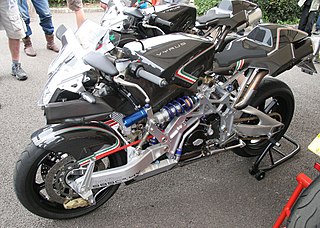
Hub-center steering (HCS) is one of several different types of front-end suspension/steering mechanisms used in motorcycles and cargo bicycles. Hub-center steering is characterized by the steering pivot points being inside the hub of the wheel, rather than above the wheel in the headstock as in the traditional layout. Most hub-center arrangements employ a swingarm that extends from the bottom of the engine/frame to the center of the front wheel.

A friction drive or friction engine is a type of transmission that utilises two wheels in the transmission to transfer power from the engine to the driving wheels. The system is naturally a continuously variable transmission; by moving the two disks' positions, the output ratio changes continually. Although once used in early automobiles, today the system is most commonly used on scooters, mainly go-peds, in place of a chain and gear system. It is mechanically identical to a ball-and-disk integrator, but intended to handle higher torque levels.

Sheffield-Simplex was a British car and motorcycle manufacturer operating from 1907 to 1920 based in Sheffield, Yorkshire, and Kingston upon Thames, Surrey.

The Wartburg 353, known in some export markets as the Wartburg Knight, is a medium-sized family car, produced by the East German car manufacturer AWE for their Wartburg brand. It was the successor of the Wartburg 311, and was itself succeeded by the Wartburg 1.3.
Motorcycle components and systems for a motorcycle are engineered, manufactured, and assembled in order to produce motorcycle models with the desired performance, aesthetics, and cost. The key components of modern motorcycles are presented below.
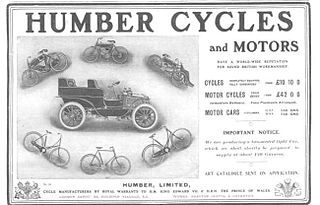
Humber Limited was a pioneering British motorcycle manufacturer. Humber produced the first practical motorcycle made in Britain by fitting one of their Humber bicycles with an E. J. Pennington two-horsepower motor in 1896.
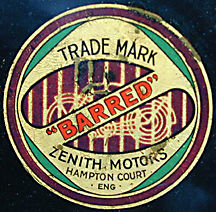
Zenith Motorcycles was a British motorcycle and automobile manufacturer established in Finsbury Park, London in 1903, by W.G. Bowers. Automobile manufacture only lasted from 1905–1906. The first Zenith motorcycle was the 'BiCar' of 1903, based on Tooley's Bi-Car design, which was purchased by Zenith for its own production. The BiCar was a unique design with hub-center steering and a low-slung chassis with the engine centrally fixed.
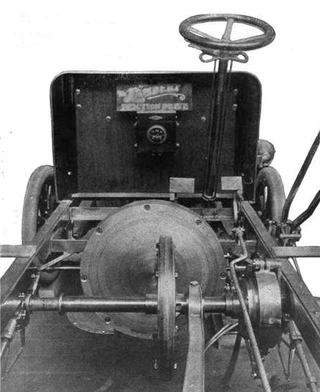
The Lambert friction transmission was a mechanism devised and patented by John W. Lambert in 1904. It was a mechanical transmission that consisted of a friction wheel pressed against the back of the automobile motor flywheel main disk by a pedal controlled by the driver's foot. It was a type of clutch. When the pedal pressure was released the friction wheel could be moved across the power flywheel disk to provide a different ratio to give a driving speed as high or as low as desired; it even went into reverse to help decelerate while going forward or for driving backwards. The transmission was used in all of the vehicles manufactured by Lambert.

Simplex Manufacturing Corporation was an American manufacturer that made motorcycles from 1935 to 1975. Between 1935 and 1960, Simplex made variations of the Simplex Servi-Cycle including the 1953–1960 Simplex Automatic. Simplex was the only motorcycle manufacturer located in the Deep South for many years, until Confederate Motorcycles began production.

Car controls are the components in automobiles and other powered road vehicles, such as trucks and buses, used for driving and parking.
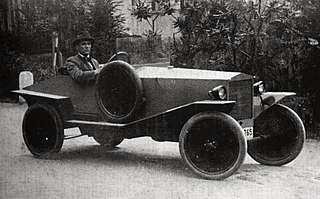
The Novo was a Czech automobile prototype designed by Břetislav Novotný.




















